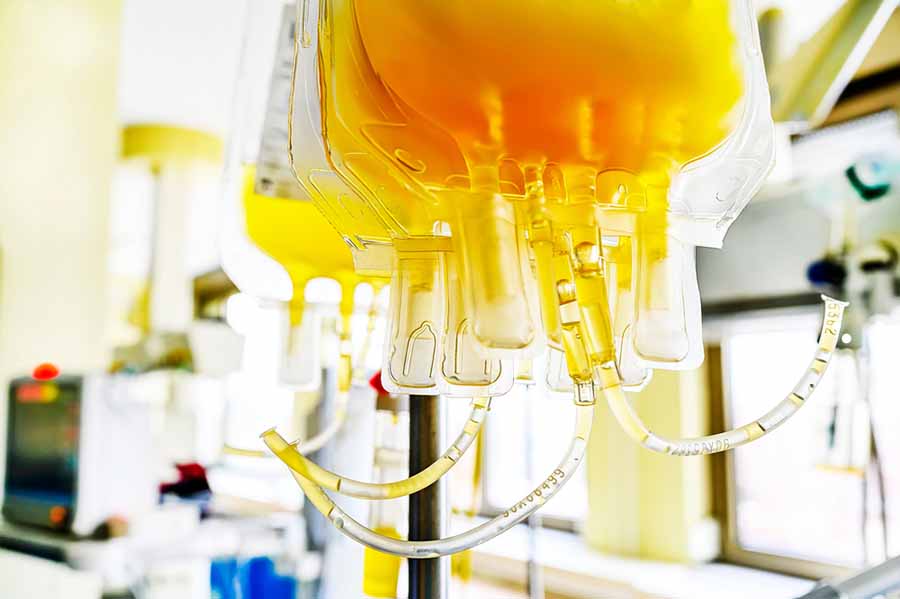Jeffrey P. Henderson, M.D., Ph.D. of Washington University in St. Louis School of Medicine and a Longer Life Foundation (LLF) grant recipient, is one of the scientists at the forefront of research into using convalescent plasma (CP), i.e., plasma from those who have recovered from COVID-19, to help those with active disease. He recently provided deeper insight and perspectives on the subject and his work in an interview with ReFlections.
How did you become involved in this innovative line of COVID-19 research?
The effort began when Arturo Casadevall, M.D., Ph.D. at Johns Hopkins’ Bloomberg School of Public Health, approached Michael J. Joyner, M.D., who is with the Mayo Clinic, and me about the possibility of collecting convalescent plasma (CP) on a national scale from patients who have recovered from COVID-19, and then using it to develop possible treatments.
Will you use plasma or serum in your research?
There is a rich history here. At the dawn of the twentieth century it was found that the yellow liquid remaining after blood clots – serum – could be used to treat and prevent certain infections. It was later appreciated that serum contains antibodies. We can now harvest antibodies by removing cells from blood and keeping the liquid – plasma – that remains. We plan to use plasma because it is better tolerated by patients than serum and can be collected in greater volume.
Presumably, infected individuals produce multiple antibodies against SARS-CoV-2. Do we know if any or all of these might be protective (prevention/prophylaxis) as well as therapeutic?
A clear therapeutic effect from CP would be strong evidence favoring a role for antibodies in controlling clinical SARS-CoV-2 infections. The immune system generates numerous antibodies recognizing numerous antigens following infection by a viral pathogen like SARS-CoV-2. Any two antibodies may recognize different viral proteins or different parts of the same protein. Some, but not all, of these antibodies are able to prevent SARS-CoV-2 from infecting cells in culture. We will look with interest to see which, and how many, of these antibodies can prevent or treat infections in animal models of disease. Antibodies may also do other helpful things that aren’t evident from experimental cultures. We will be open to finding these surprise interactions, if they are present.
Will your trial focus on using CP in only severely/critically ill patients? If so, given the heterogeneity of the patient population as well as the significant other complications which can occur, will it be difficult to control for confounders?
Right now, CP is not being used in a controlled trial, and the decision to transfuse it is at the discretion of treating physicians, with patient approval. We are all still learning about the pathophysiology of the disease. There is likely a point in the development of COVID-19 where the tissue damage already done by the virus plays a larger role in the patient’s status than the virus alone. In these situations, the possible antiviral effects of CP may be insufficient to significantly alter the disease’s course.
Does CP therapy have the potential to be a game changer, or is it more likely to only marginally improve the relative risk of death for COVID-19 patients?
Following the limited experience of CP for SARS, which is caused by a coronavirus related to the COVID-19 agent, it seems likely that its greatest impact may be in early disease. A Lazarus-like effect in the severely ill is unlikely. We will watch with great interest as clinical experience with CP accrues.
Is there research looking at preventative uses of plasma or derived gamma globulin (or pooled hyperimmune globulin) in health care workers, the elderly, or those with a significant comorbid burden?
There is certainly interest and activity in many quarters on this; specifically, the use of a purified standardized gamma globulin preparation as well as of monoclonal antibodies with similar properties. The ability to deliver a more standardized dose, to concentrate the product, and to produce it in large quantities would certainly facilitate use for passive immunization of high-risk individuals until a vaccine can be developed. This kind of product, however, will require a longer development and approval time. CP, if effective, may fill that developmental gap until a purified product becomes available.
Could this research help inform those working on vaccines? Will knowing which antibody components are the most protective or therapeutic drive certain vaccine strategies? Or does your approach simply utilize whole, unprocessed plasma without identification of specific antibodies?
Our current approach utilizes whole plasma, which is FDA- approved. We qualify donors based on the existence of a minimal level of antibodies to the antigenically distinctive SARS-CoV-2 spike protein. With additional characterization of plasma, and possibly correlation with clinical outcomes, we hope to discern viral antigens that will stimulate an optimal protective immune response in a future vaccine.
How is your current research related to your past urinary tract infection (UTI) research which was funded by the Longer Life Foundation?
In both cases, preventing severe disease in high-risk patients has been a major focus. My LLF project sought to identify correlates of UTI susceptibility in elderly patients, with a focus on identifying and preventing septicemic progression. That particular focus on preventing progression to serious disease in that project mirrors the likely therapeutic niche for CP in COVID-19.



